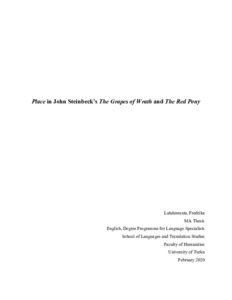Place in John Steinbeck’s The Grapes of Wrath and The Red Pony
Lahdenranta, Fredrika (2020-03-03)
Place in John Steinbeck’s The Grapes of Wrath and The Red Pony
Lahdenranta, Fredrika
(03.03.2020)
Julkaisu on tekijänoikeussäännösten alainen. Teosta voi lukea ja tulostaa henkilökohtaista käyttöä varten. Käyttö kaupallisiin tarkoituksiin on kielletty.
avoin
Julkaisun pysyvä osoite on:
https://urn.fi/URN:NBN:fi-fe202003188433
https://urn.fi/URN:NBN:fi-fe202003188433
Tiivistelmä
This thesis examines the literary places in John Steinbeck’s The Grapes of Wrath (1939) and The
Red Pony (1933). In the thesis I analyze how literary places, such as the ones in these two
aforementioned novels, are created. The creation of these places is divided into three main
categories: creating the place through physicality, forming it through cultural or social references
and creating it through a personal connection or individual affect. These categories are used in the
analysis that focuses on The Grapes of Wrath.
In this thesis, I argue that the use of imagery and chronotope create the physical place. In addition,
the cultural and social place is created through the shifting focalization that reveals differing
cultural values and significance. Furthermore, place is also envisioned through personal
relationship or attachment, for example memory and identity. These three categories are based on
the theory of analyzing place by the ecocritic Lawrence Buell. His theory and texts on environment
and place work as the basis of the analysis. The thesis also examines place attachment in The Red
Pony through Mikhail Bakhtin’s chronotope and Martin Heidegger’s concept of Being.
The approach of the thesis is ecocritical, and its focus is also to discuss the human-nature
relationship in Steinbeck’s fiction as well as argue that examining place centered literature can
prove to be meaningful in understanding the role of humans within their environment. The thesis
also briefly examines the ideas of representing and constructing nature in relation to ecocriticism
and nature writing.
Red Pony (1933). In the thesis I analyze how literary places, such as the ones in these two
aforementioned novels, are created. The creation of these places is divided into three main
categories: creating the place through physicality, forming it through cultural or social references
and creating it through a personal connection or individual affect. These categories are used in the
analysis that focuses on The Grapes of Wrath.
In this thesis, I argue that the use of imagery and chronotope create the physical place. In addition,
the cultural and social place is created through the shifting focalization that reveals differing
cultural values and significance. Furthermore, place is also envisioned through personal
relationship or attachment, for example memory and identity. These three categories are based on
the theory of analyzing place by the ecocritic Lawrence Buell. His theory and texts on environment
and place work as the basis of the analysis. The thesis also examines place attachment in The Red
Pony through Mikhail Bakhtin’s chronotope and Martin Heidegger’s concept of Being.
The approach of the thesis is ecocritical, and its focus is also to discuss the human-nature
relationship in Steinbeck’s fiction as well as argue that examining place centered literature can
prove to be meaningful in understanding the role of humans within their environment. The thesis
also briefly examines the ideas of representing and constructing nature in relation to ecocriticism
and nature writing.
